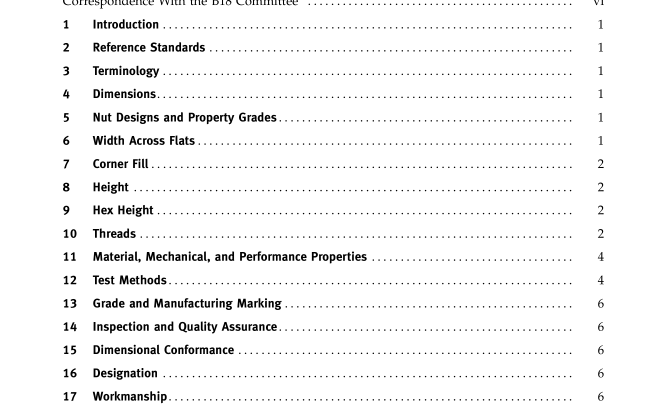ASME B18.19-2008 pdf free download.Nylon Insert Locknuts (Inch Series)
11 MATERIAL, MECHANICAL, AND PERFORMANCE PROPERTIES
11.1 Material and Processes 11.1.1 Material. Carbon steel nuts shall conform to the requirements of Table 4. Alternate material may be used if agreed upon with the purchaser. The nylon insert material shall be sufficient to meet the prevailing-torque requirements of Tables 2 and 3 when tested as specified in para. 12.3.
11.1.2 Heat Treatment. Grade NE2 nuts shall not be heat treated. Other nut grades may be heat treated as necessary (see Table 5) to meet the mechanical and performance requirements of this Standard, except that they shall not be case hardened.
11.1.3 Finish. Nuts may be furnished plain (bare metal) or with a protective coating as specified by the purchaser. The performance of nuts that are furnished with a protective coating shall notdeteriorate when nuts are stored indoors for a period of 6 months.
In cases where nuts are given a protective coating or are cleaned following delivery to the purchaser, the nut producer shall not be held responsible for failures of the nut to meet dimensional, mechanical, or performance requirements traceable to plating, coating, or cleaning practice.
11.1.4 Hydrogen Embrittlement. Nuts shall not be embrittled. When heat-treated nuts are electroplated or phosphate coated, appropriate plating or coating pro- cesses should be employed to avoid hydrogen embrittle- ment. If necessary, the product shall be suitably treated as soon as practicable afterplating orcoatingto preclude detrimental hydrogen embrittlement.
11.2 Mechanical Requirements
11.2.1 Proof Load. Nuts shall withstand the proof load specified for the applicable grade and thread series in Table 2 or 3 when tested as specified in para. 12.1.
11.2.2 Hardness. Nuts shall have a hardness con- forming to the limits specified for the applicable grade in Table 5 when tested as specified in para. 12.2. 11.3 Performance Requirements
11.3.1 Prevailing-Torque. The prevailing-torque developed by nuts during their first installation, or any subsequent installation or removal, shall not exceed the maximumfirstinstallationtorquespecifiedforthe appli- cable grade in Table 2 or 3 when tested as specified in para.
12.3. In addition, minimum prevailing-torque generated by nuts during their first and fifth removals shall not be less than the respective removal torques specified for the applicable grade in Table 2 or 3.
12 TEST METHODS
12.1 Proof Load Test The test sample nut shall be assembled on a test bolt (see para. 12.1.1) or on a hardened mandrel (see para. 12.1.2) with a minimum of three threads projecting through the nut. The proof load test may be performed prior to the prevailing-torque feature being added to the nut. For referee test purposes, the hardened mandrel shall be used and the prevailing-torque feature present. The maximum prevailing-torque occurring during the assembly of the nut on the test bolt or mandrel shall be recorded. A load equal to the specified proof load for the nut, as given in Table 2 or 3, shall be applied in tension or compression through the test bolt or mandrel against the nut bearing surface in an axial direction. For referee purposes, the load shall be applied in tension. The nut shall resist this load without thread stripping or rupture. The prevailing-torque necessary to remove the nut from the test bolt or mandrel shall not exceed the maximum torque occurring during assembly.
12.1.1 TestBolt. The boltused forproofload testing a nut shall have threads conforming to Class 2A toler- ances as specified in ASME B1.1. The test bolt shall have a yield strength in excess of the specified proof load of the nut being tested.
12.1.2 Hardened Mandrel. The hardened mandrel used for proof load testing a nut shall have threads conforming to Class 3A tolerances as specified in ASME B1.1, except that the major diameter shall be the minimum major diameter with a plus tolerance of 0.002 in. The mandrel shall be heat treated to a hardness of Rockwell C45 to C50.
12.2 Hardness Test The Rockwell hardness of a sample nut shall be deter- mined on the top face of the nut. The top surface of the nut shall be prepared by grinding and removing sufficient material from the top to eliminate the effects of plating, coating, or other surface conditions. Material removal shall also be such as to provide a flat area large enough to allow a hardness test to be made midway between the hex corner and the major diameter of the thread. The bearing surface of the nut shall be prepared parallel to the test surface with removal of plating or coating. Further preparation of the test specimen and the method of performing the test shall conform to ASTM E 18.ASME B18.16 pdf download.ASME B18.19-2008 pdf free download
